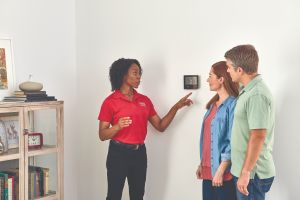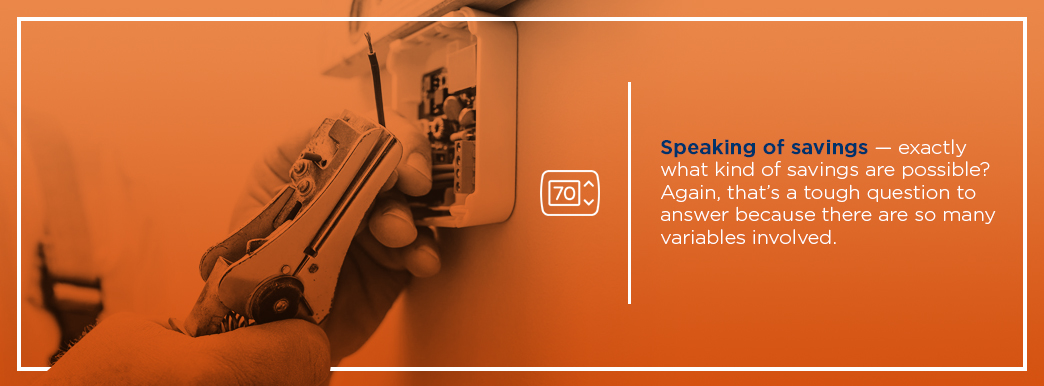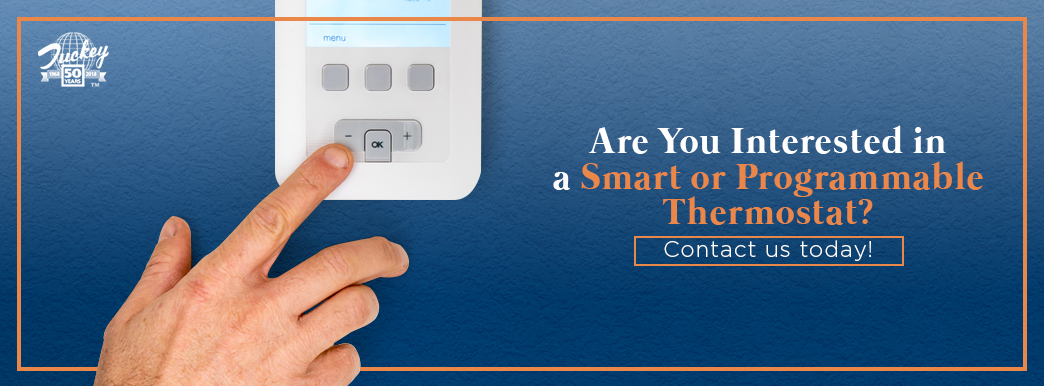Ask Our Experts: Are Programmable Thermostats Worth It?
December 13, 2019 | 1:49 pm
You might have heard that programmable thermostats may lead to significant cost and environmental savings — but are programmable thermostats really worth it?
This is a smart question, but it’s impossible to give a detailed answer on cost or environmental savings without knowing the details of your home or building, your HVAC system and your comfort preferences. That being said, programmable thermostats are generally “worth it” if your building is unoccupied for several hours during the day and if you’re willing to sacrifice a certain level of comfort for the sake of savings.
We can provide some general guidance and insight that should help you flesh out the details of a cost-benefit analysis on your own — or equip you to speak knowledgeably with a contractor about your needs.
- The Difference Between Manual and Programmable Thermostats
- What Factors Should You Consider When Choosing Between a Manual and Programmable Thermostat?
- Do Programmable and Smart Thermostats Really Save You Money?
- Helpful Tips for Managing A Programmable Thermostat
The Difference Between Manual and Programmable Thermostats
A basic, traditional thermostat essentially has one job — make sure that the actual room temperature matches the desired temperature set by the owner. The owner can change the desired temperature — up or down as necessary — and a basic thermostat will keep the room at that temperature until the set temperature is manually changed again by the owner.
A few decades ago, programmable thermostats were introduced to the market as a cost-and-energy-saving tool for homeowners and facility managers. Home and business owners can set a schedule on programmable thermostats — also known as clock thermostats — that tell the thermostats to automatically adjust the temperature at different times throughout the day.
For example, a business owner can cut back on air conditioning during the middle of a summer night, when all employees have gone home for the day. A homeowner could use less heating in the middle of a winter night if everyone is sleeping under warm covers and wouldn’t notice a cooler home. A programmable thermostat automates the adjustment and ensures energy savings, which translate to cost savings on your energy bill.
Smart Thermostats
Programmable thermostat technology has come a long way since it was originally introduced years ago. Mobile computing and computer networking technology enhance the management capabilities of programmable thermostats substantially, enabling further savings and more precise adjustments. The result? Smart thermostats.
Wi-Fi-enabled thermostats — also called smart thermostats — are programmable thermostats that connect to an Internet-powered device, like your phone or tablet, through your home or business’ Wi-Fi connection. Smart thermostats often come with smartphone apps or personalized website accounts that allow the owner to monitor their HVAC system and adjust temperature settings even while away from the home or business. This could be a huge energy-and-cost saver if you forgot to turn down your thermostat or adjust its schedule before leaving for a week-long trip.
Smart thermostats offer several features, including:
- Habit learning: Some smart thermostats learn your activity habits over time by analyzing when you’re in the building and observing your comfort preferences and use this information to help you make better decisions regarding when to turn down your thermostat and for how long.
- Diagnostic features: Some smart thermostats can detect a problem with your HVAC system or thermostat.
- Reminders: Some smart thermostats remind you when it’s time to change your air filters or schedule routine maintenance. They can also let you know about high and low temperatures and periods of high or low humidity.
- Geo-fencing technology: Some modern thermostats employ geofencing technology when paired with your smartphone. Essentially, these thermostats know when you’re close-by — returning from work, for example — and adjust temperature settings accordingly so that your home is at the right temperature as you pull into the garage.
- Voice commands:Other smart thermostats respond to voice commands, making it easier than ever for the owner to adjust settings on-the-fly.
- Report generating: Many smart thermostats generate reports that record energy and cost savings over time, which allows you to make better decisions about your energy settings and the temperature of your home.
What Factors Should You Consider When Choosing Between a Manual and Programmable Thermostat?
One in eight homes in the United States use a programmable thermostat for their central air — but what factors into the decision on whether programmable thermostats are “worth it” for your home or office? Some things to consider:
- Building occupation: Is your building left empty for long periods throughout the day? If so, then you probably want to consider a programmable thermostat. If everyone is routinely away from home Monday through Friday, 8:00 a.m. to 5:00 p.m. for work and school, and you set your air conditioner to 80 degrees rather than 70 during this period, you stand a chance of realizing some notable savings. On the other hand, if someone is in the building all or most of the time, then you will likely desire a more stable room temperature.
- Comfort vs. savings: Are you willing to sacrifice a certain level of comfort for savings? If so, consider using a programmable thermostat to automatically reduce the load on your HVAC system during those hours of the day when you’re willing to sacrifice some comfort. Winter nights are a good example — you could program your thermostat to reduce room temperature from 70 to 64 degrees overnight, and then back up to 70 in the morning. Most people won’t notice the temperature difference while sleeping, and you may be able to save up to 10% a year on energy bills just by turning your thermostat a few degrees, eight hours a day.
Learn About Our Thermostat Services
Do Programmable and Smart Thermostats Really Save You Money?
Speaking of savings — exactly what kind of savings are possible? Again, that’s a tough question to answer because there are so many variables involved. The answer depends on your heating fuel type, the insulation in your building, your specific geographic location and more. Wing (2012) reports, “As rules of thumb, lowering a thermostat permanently reduces heating bills by about 3% per degree Fahrenheit, while lowering it overnight only saves about 1% per degree Fahrenheit.”
One manufacturer reports that homeowners may save an average of 20% on their heating and cooling costs over time, depending on the type of programmable thermostat that’s selected and which heating and cooling equipment used with it.
Smart thermostats save you money by cooling and heating your home only as needed, cutting back on wasted energy. Additional features, like service reminders and diagnostic tools, help you save more in the long-run by keeping your HVAC system in good shape.
The average programmable thermostat costs about $100 to $200. The money you save in the first year of using a smart or programmable thermostat will likely cover most of this initial cost.
However, there are some circumstances in which a smart or programmable thermostat may not save you money. For example, if your home or business is located in a very cold or very hot climate, you may see fewer energy savings due to the amount of energy needed to keep the temperature of your home at a stable level. In South Central Pennsylvania, however, the climate is usually not a concern.
If the thermostat has a lot of additional features — though they may be convenient to have — it may use additional energy. If you are trying to save money on your energy bills, a simple programmable thermostat may be a better fit.
Consistency also matters when using a smart thermostat. If you use thermostat setbacks to monitor your temperature and keep it lower while you are away, but then hike it up later in the evening, you will use more energy. Additionally, if you are continually overriding your temperature settings, you reduce your thermostat’s ability to save energy.
Understanding and consistency are key to finding success with a programmable thermostat. If used correctly, a programmable thermostat may save you money on your energy bills.
Helpful Tips for Managing a Programmable or Smart Thermostat
If you are interested in installing a programmable or smart thermostat in your home, there are some tips you should follow to get the most value for your dollar:
- The location of your thermostat matters. For example, a thermostat should be placed on an interior wall away from sunlight or drafts. Do not place thermostats on walls near large furniture, as this can block airflow.
- If you decide to install a smart thermostat, make sure you have a strong Internet and Wi-Fi connection to take full advantage of all the features your smart thermostat offers.
- Many programmable thermostats are battery-operated. If you elect to install a programmable thermostat, make sure you change the batteries as needed.
- Programmable thermostats usually have two different hold features — permanent or vacation and temporary hold. You should only use the permanent or vacation hold when you are planning to be away from your home or office for an extended period. You will waste energy if you use it for daily temperature management.
- Many homes use a single thermostat for the whole house. If your home has hot and cold spots, you may want to invest in programmed thermostat setbacks for each of these areas to ensure ultimate comfort and that you are saving as much energy as possible.
Are You Interested in a Smart or Programmable Thermostat?
If you are interested in a smart or programmable thermostat, the team at Tuckey Mechanical Services Inc. can give you the best service and the best units at the best price possible.
Tuckey Mechanical Services provides HVAC system installation, maintenance and repair services throughout South Central Pennsylvania, including York, Harrisburg, Chambersburg, Boiling Springs, Carlisle, Mechanicsburg, Newville, Shippensburg and many more. Give us a call at (717) 249-1535 or contact us online today to schedule an appointment.
All material Copyrighted (c) by the Tuckey Companies, 2025.





